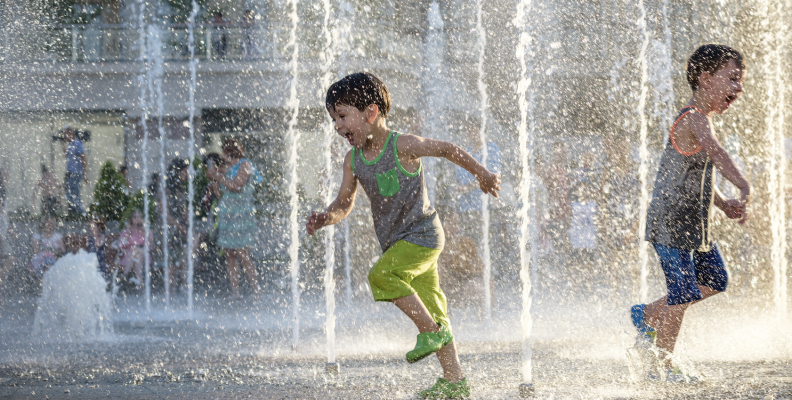Making a Splash with Water Safety
School is out but safe water practices are always in! Make your summer more secure by making water safety a priority.
Summer is here and with temps rising, more people are hitting the pool or beach! We believe everyone should enjoy some fun in the sun and believe you can have an even better summer when you have some peace of mind.
In the United States, drowning is the number one cause of death for children between 1-4 years old. It can happen silently, quickly (in as little as 20-60 seconds), and in just a few inches of water. And with the CDC reporting drowning deaths on the rise in 2024, it’s more important than ever to promote water safety awareness.
These stats may sound scary but are not a reason to avoid the water. By developing water competency – a way to improve water safety for yourself and others – you’ll develop skills to promote safety and handle an emergency if needed. Check out some of our water safety tips below to start your journey towards a safer, healthier summer!
Water Safety 101
1. Never leave a child unsupervised around water: It’s important to keep a watchful eye on children (especially new swimmers) when they’re near the water, and to do so without distractions such as phones or wandering away. Accidents can happen in a blink of an eye—even in as little as 1-2 inches of water!
2. Encourage safety and confidence by enrolling children in swim lessons: Learning to swim isn’t just a fun activity for kids; it’s also a key skill to help minimize the risk of a drowning accident! All children develop differently, so determining what age to begin swim lessons may vary.
3. Remember the buddy system: In addition to adult supervision, it is also beneficial to follow the buddy system. Having a swimming buddy helps keep children safer, preventing one another from wandering off and allowing one of them to alert an adult or lifeguard if the other is having trouble.
4. Implement water safety measures at home: Drowning accidents can happen at the pool or around the house. For an extra layer of safety, consider adding safety measures like fencing in pools, emptying kiddy pools or buckets when not in use, and closing lids or doors to bathrooms and laundry rooms.
5. Consider safety specific to your environment: Water safety is important regardless of where you are: at home, the pool, or even beaches and lakes. Some environments require additional safety measures, such as wearing life vests or not allowing children to dive in water less than 9 feet deep.
6. Talk to your child about water safety: Water safety is a team effort! Talking to a child about water safety provides them with an extra layer of security. You should discuss topics such as never swimming alone, entering the water feet-first, and not diving into shallow water.
7. Be prepared for an emergency: While no one wants to imagine their child in distress, it’s important to be ready for an emergency. Learning CPR and basic water rescue skills are two ways to stay prepared and find some peace of mind when your little ones are near the water this summer.
Looking for swim classes for you or your little one? Check out these local resources:
City of El Paso’s Aquatic Centers The City of El Paso offers a number of beginner swimming lessons for all age groups—including Level 1 (Beginner), Parent/Child, and Pre-School groups. Visit their website to enroll online.
YMCA of El Paso The YMCA offers a number of swim classes for children and adults alike, including an 8-day Safety Around Water course. Financial assistance is available. To learn more and register, contact your nearest YMCA location.
YWCA El Paso del Norte Region The YWCA offers class-based swim lessons for infants, toddlers, and children at all four of their El Paso locations, with classes open to children as young as 6 months old. To learn more and register, contact the YWCA.
Additional Resources
While this isn’t a comprehensive guide to water safety, we believe utilizing the tips from the list is a great start to ensuring your family’s health and well-being this summer. For even more tips on water safety, visit any of the resources below:
- American Red Cross Water Safety
- National Drowning Prevention Alliance</a>
- Stop Drowning Now (SDN)
- John Hopkins Medicine Water Safety for Parents
Resources & References
- American Academy of Pediatrics. (2024, May 29). Swim Lessons: When to Start & What Parents Should Know. HealthyChildren.org.
- The American National Red Cross. (n.d.-b). Water Safety. American Red Cross.
- The American Red Cross. (n.d.). Get Your CPR, First Aid, and AED Certification. American Red Cross Training Services.
- Johns Hopkins Medicine. (2024, June 21). Water Safety for Parents. Johns Hopkins Medicine.
- Life Saver Pool Fence. (2023, June 7). The Buddy System: Never Swim Alone. Life Saver Pool Fence.
- National Drowning Prevention Alliance. (2023, December 6). Learn The 5 Layers Of Protection. NDPA.
- Stop Drowning Now. (2020, August 27). Facts & Stats About Drowning. Stop Drowning Now.
- Sibley Horton, K. (n.d.). 7 Water Safety Tips for Parents. GetParentingTips.com.
- U.S. Department of Health & Human Services. (2024, May 14). Drowning Deaths Rise in the United States. Centers for Disease Control and Prevention.





